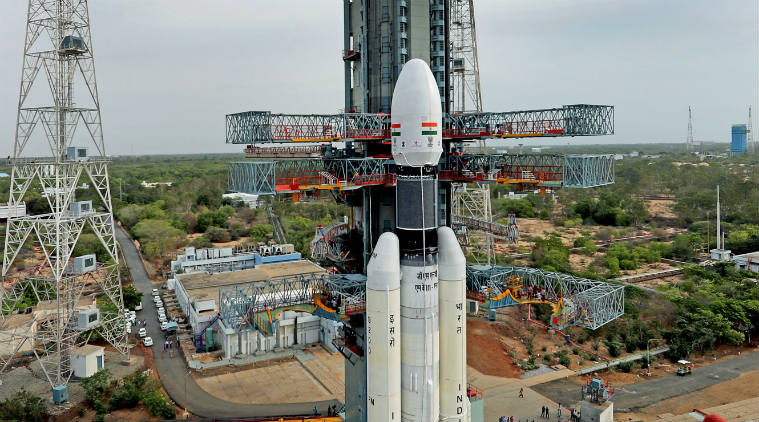- India
- International
Chandrayaan-2 rescheduled to launch on July 22: Everything you need to know
Chandryaan-2 has been rescheduled to launch on July 22 from Satish Dhawan Space Centre in Sriharikota. Here is everything you need to know about ISRO's mission to Moon.
 Chandrayaan-2 to launch on July 22: All you need to know about the mission. (Image source: ISRO)
Chandrayaan-2 to launch on July 22: All you need to know about the mission. (Image source: ISRO)
The Indian Space Research Organisation (ISRO) will launch its Chandrayaan-2 mission to deliver a rover to the Moon’s South Pole on July 22, days after a “technical snag” forced the space agency to postpone the mission.
If the Chandrayaan-2 becomes successful, India will become only the fourth nation to land a rover on the lunar surface. The other three nations include the United States, Russia, and China. Here is everything you need to know about the Chandrayaan-2 mission.
Chandrayan-2 launch site and components
ISRO will launch the Chandrayaan-2 mission to the Moon from Satish Dhawan Space Centre in Sriharikota, Andhra Pradesh. The unmanned mission will be launched onboard the Geosynchronous Satellite Launch Vehicle (GSLV) Mark-III to “soft land” on the Moon’s South Pole.
This is India’s first attempt to soft-land on the lunar surface and the first-ever attempt by any space agency to soft-land on the South Pole of the Moon. Chandrayaan-2 carries an orbiter, a lander, and a rover. All of these components have been made by the ISRO.
Reason to postpone the July 15 launch
The July 15 launch was called off after to a technical snag was detected in the GSLV-MkIII rocket, India’s most powerful rocket built to carry heavy payloads. While the ISRO did not specify the details of the snag, there were indications that the problem was detected in the upper stage of the rocket carrying the cryogenic engine where liquid hydrogen fuel had been filled less than half an hour earlier.

How Chandrayaan-2 would reach the Moon
The distance between the Earth and the Moon can be covered in three to four days if a spacecraft travels directly in a straight line. But ISRO does not have such a powerful rocket like the Saturn V to reach the Moon in one shot. Chandrayaan-2 will ride the GSLV Mk-III rocket, which is the most powerful built by ISRO.
 An illustration of the journey of the Chandrayaan-2 (Image source: ISRO)
An illustration of the journey of the Chandrayaan-2 (Image source: ISRO)
It will go around the Earth’s orbit for a few days, fire thrusters to slowly increase its orbit and eventually acquire enough energy to reach the moon’s orbit.
As per the original schedule, the Chandrayaan-2 was supposed to remain in the earth’s orbit for the first 17 days after the launch and incrementally increase its orbit several times before heading towards the lunar orbit for a five-day journey. Next, the Chandrayaan-2 would have spent 28 days orbiting the moon after which the lander and the rover would have separated and prepared for landing on the surface on September 6. It would have taken the Chandrayaan-2 a total of 54 days to reach the Moon’s surface.
Chandrayaan-2 to land on Moon on September 7, 2019
The Chandrayaan-2 is scheduled to land on the lunar surface on September 7, 2019, a day after the originally planned date. The date is crucial for the moon landing as it will maximise data collection by the instruments on the lander and rover of the Chandrayaan-2. ISRO chose this date to avoid any lunar eclipse to ensure the illumination from sunlight.
Also read | Explained: Behind Chandrayaan-2’s GSLV Mk-III rocket that developed a glitch
The lander will land near the South Pole of the Moon and carry out experiments on the lunar surface for a period of one lunar day, which is equal to 14 Earth days. ISRO says that the orbiter will continue its mission for a duration of one year.
Chandrayaan-2 on the lunar surface
“The orbiter payloads will conduct remote-sensing observations from a 100 km orbit while the lander and the rover payloads will perform in-situ measurements near the landing site,” ISRO states.
For an understanding of the Lunar composition, the Chandrayaan-2 mission will study the measurements on the near-surface plasma environment and electron density in the lunar ionosphere. The mission will also measure the thermophysical property of the lunar surface and seismic activities. The mission will also study the water molecule distribution using infrared spectroscopy, synthetic aperture radiometry & polarimetry as well as mass spectroscopy techniques.
It was supposed to be a joint mission
ISRO’s original plan was to launch the Chandrayaan-2 as early as in 2010 or 2011, immediately after the 2008 Chandrayaan-1 mission. The project was supposed to be a joint India-Russia mission with the ISRO delivering the launcher and the Orbiter, and the Russian side contributing the lander and rover. But the collaboration was called off because of differences between the two sides leaving India to make its own lander and rover.
More Tech
Apr 26: Latest News
- 01
- 02
- 03
- 04
- 05
































